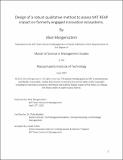Design of a robust qualitative method to assess MIT REAP impact on formerly engaged innovation ecosystems.
Author(s)
Morgensztern, Alice
DownloadThesis PDF (796.8Kb)
Advisor
Budden, Philip
Terms of use
Metadata
Show full item recordAbstract
The MIT Regional Entrepreneurship Acceleration Program (REAP) is a program that seeks to create efficient regional innovation-driven entrepreneurial ecosystems worldwide. The program engages with various communities internationally and aims to help regional Teams gain a deeper understanding of the strengths and weaknesses of their innovation ecosystem. This is done by evaluating the engagement and level of collective impact by regional stakeholders.
The REAP program is grounded in MIT five stakeholders model, a modernization of the triple helix model, which is one of the foundational academic theories on innovation ecosystems. The program runs for two years and welcomes approximatively eight Teams in each cohort. The curriculum has been structured to foster collaboration among stakeholders and long-term engagement in building a sustainable and impactful strategy for the regional ecosystem. After the program ends, it encourages the creation of a Back-bone Organization to consolidate a longlasting organization capable of implementing a Must Win Battle. It is important to both initiate and sustain the acceleration deriving from the REAP program.
We developed a methodology to assess the impact that REAP has had on the ten cohorts of regional ecosystems that participated in the program. Given the early stage of the reflection, the variety of regions involved, the need for detailed and contextualized data, the number of factors of failure or success, a qualitative assessment method based on interviews is the most relevant. The research was conducted by designing a questionnaire and interviewing nine former champions of Teams that participated in REAP from all around the world.
The analysis helped to better understand the individual Team journeys, including the diversity of regions and their specific challenges, the immediate outcomes of REAP for each region, and the extent to which they were able to maintain the momentum after REAP to continue having an impact on the regional ecosystem. Additionally, the key factors of success and failures for the Teams when going through REAP were identified, such as the five stakeholders' 3 engagement, the crucial role of the champion in building the right Team dynamics during and after the program, the necessity to nourish positive relationships within the Team and among stakeholders to foster collaboration, and the need to select stakeholders’ representatives that have strong local engagement.
Finally, recommendations were made to manage those issues efficiently and further improve the REAP program to make the most of its ten years of implementation. The recommendations tackle the building of the right Team's dynamics, the design of the right cohorts and curriculum, the importance of alignment, and the leverage of the international network. Overall, the recommendations can help REAP enhance its effectiveness and continue having a positive impact all around the world.
Date issued
2023-06Department
Sloan School of ManagementPublisher
Massachusetts Institute of Technology